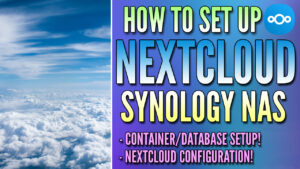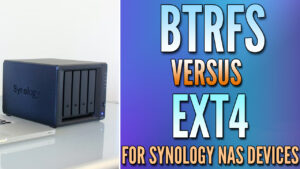In this article, we will look at Synology vs. TrueNAS and determine which is the best NAS operating system/device.
When you’re starting to look at either purchasing or building a NAS device, there are many factors that should be considered. In this article, we’re going to take a look at some of the main differences between a Synology NAS and TrueNAS so that you can determine the path that you’d like to take when trying to pick between each option.
TrueNAS is the new name for the legacy FreeNAS system.
Synology vs. TrueNAS: Side-by-Side Comparison
The main difference between Synology and TrueNAS is that Synology is a device you’ll purchase that comes with the DSM operating system, while TrueNAS is a NAS OS that you can install on your own hardware. The other major difference is that Synology uses the Btrfs or Ext4 filesystem, while TrueNAS uses ZFS.
There are other major differences between Synology and TrueNAS, in terms of hardware, operating systems, and software. We’ll compare each below.
Hardware Differences
There are significant differences between Synology and TrueNAS devices which we’ll take a look at below.
Synology Hardware
If you’d like to use a Synology NAS, your options are extremely limited as you can only use DSM (Synology’s operating system) if you’re using Synology hardware. Synology offers a bunch of different options (check out our Synology NAS buying guide to learn more), but there’s a fairly large downside with Synology hardware – it’s old.
In most Synology devices, you’ll be running components that are 3-5+ years old (CPU for example). Therefore, you’re paying a premium from a pure hardware perspective as Synology devices aren’t cheap. With that said, NAS devices don’t consume a ton of resources, so I wouldn’t say that any Synology devices are underpowered. It’s just that from a purely objective standpoint, the hardware is old.
While that might be viewed as a downside, please keep in mind that they’re extremely power efficient and you can do a lot more with them than you probably think that you can. You’ll also get support from Synology, so while the hardware might be older than other options, it will be fully supported.
TrueNAS Hardware
Unlike Synology, the hardware that you can use to run TrueNAS is for the most part, endless. TrueNAS is compatible with tons of different hardware and is a great option for people who plan on building/buying a new server or even purchasing an older, enterprise device.
There is a strong debate on the necessity of ECC memory for TrueNAS that I’m not going to get into, however, it’s important to understand that since TrueNAS uses ZFS, it’s recommended to use ECC memory. That’s not to say that it’s necessary, it’s just recommended. When selecting hardware, you should keep this in mind, as not all motherboards/processors support ECC memory, so if you want it, make sure that you’re purchasing a device that supports it.
Based on the fact that TrueNAS can run on just about any hardware, the device can be significantly more powerful than anything that Synology offers. That’s not to say that all devices will be more powerful, but that they can be more powerful if you prioritize that. However, you’ll also have to prioritize things like power efficiency if it’s important, as for the most part, all Synology devices are power-efficient, but not all TrueNAS servers you build or purchase will be.
Hardware Takeaways
The individual components inside a Synology NAS are old and somewhat outdated, but powerful enough to run a rock-solid, energy-efficient NAS device. You’ll also probably never be aware that you’re running older components as the DSM UI is fast and efficient.
TrueNAS will run on new or old hardware. It can be more or less powerful or power efficient than a Synology NAS based on the hardware that you end up purchasing. However, it’s up to you. You’re responsible for assessing the hardware and ensuring that it’s what you’re looking for, which is both a positive and a negative.
We also live in a world where the general consensus is that “more is better”, but when it comes to a NAS, it really depends. Having more raw computing power can be beneficial…if you use it. If you don’t, you’ll end up paying more from an increased energy usage perspective. Since NAS devices generally run 24/7, you should keep that in mind as your goal should be to run the most powerful but energy-efficient device that you can, based on what you’ll actually be using it for.
Operating System Differences
There are significant differences between the Synology and TrueNAS operating system which we’ll take a look at below.
Synology DSM Operating System
The Synology operating system that you’ll run is Synology DSM. Synology DSM is extremely beginner-friendly, stable, and powerful. There are a ton of different things that you can do on it and the support for it is great.
Out of everything that DSM excels in, the biggest benefit is certainly the ease of use. Synology DSM is a product that you can have up and running in as little as ten minutes. It’s also a system that you can spend hours upon hours tinkering with to unleash its true potential.
Another benefit of DSM is that you can try the operating system before buying it if you’d like!
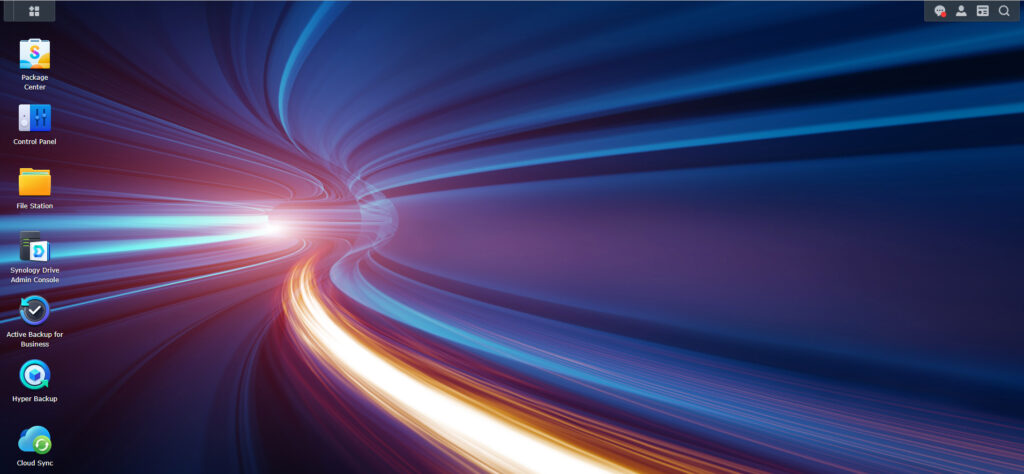
TrueNAS Operating System
TrueNAS has two flavors of the operating system that you can install and use: TrueNAS Core or TrueNAS Scale. TrueNAS Core is built on FreeBSD, whereas TrueNAS Scale is built on Debian Linux. There are minor differences between them both and you ultimately should pick the version that you’re more comfortable with based on the underlying technology (FreeBSD or Debian Linux). TrueNAS Core has been around for much longer than TrueNAS Scale, however, so if that’s important to you, go with Core.
Unlike Synology DSM, TrueNAS won’t be as beginner-friendly. After configuration, you should be able to get the same level of reliability that Synology DSM offers, but it might take a little while to get to that point.
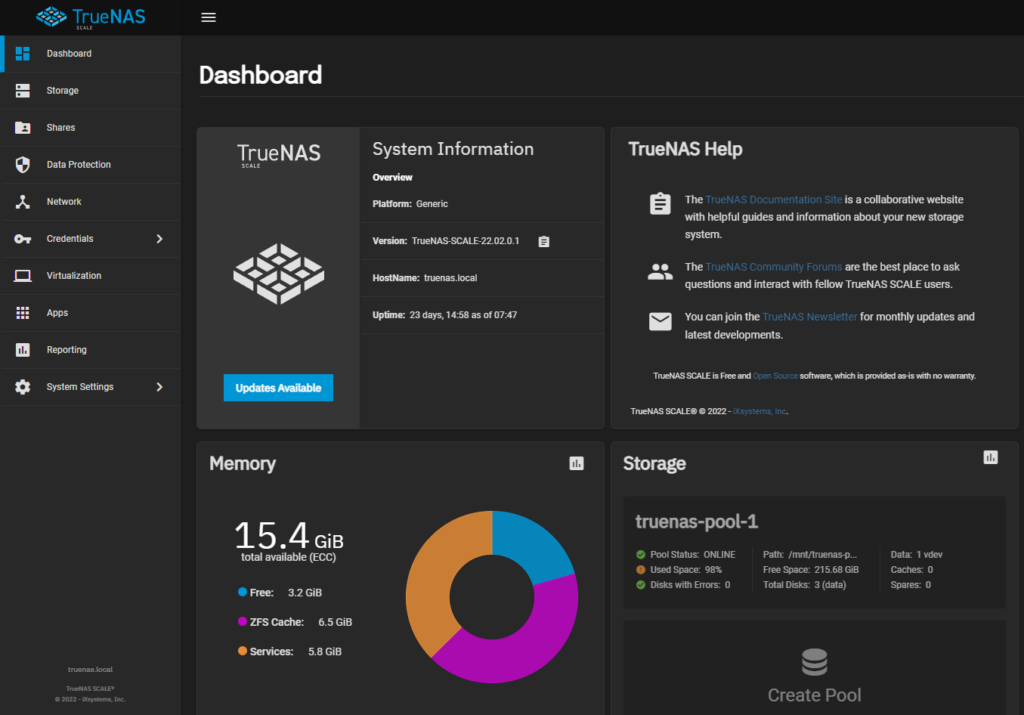
Operating System Takeaways
Synology DSM is beginner-friendly. You’ll have a web management portal for both, Synology DSM and TrueNAS, but the actual process of utilizing the system is easier if you’re using DSM. From a pure reliability standpoint, you should be able to get the same output from both, but Synology DSM will be easier to maintain.
Overall, I’d say that TrueNAS is more DIY, but that’s not necessarily a bad thing. If you want to buy something that just works, I’d highly suggest investing in a Synology NAS. However, if you want to be someone who tinkers, you can’t go wrong with TrueNAS.
I cannot stress enough that if you simply want something that works, go with a Synology NAS. You won’t have to worry about hardware compatibility, updates are generally tested well, and there aren’t many hidden issues that appear as the software is built for the hardware.
Software Differences
As mentioned above, you can use your NAS for tons of different reasons, or simply as a NAS device. If you do want to use it for other purposes, there are a few add-ons that you can use that will alter your experience.
Synology offers a bunch of first-party applications that will help you utilize your NAS for other purposes. Some of my favorites are Active Backup for Business (PC backups), Synology Drive (document management), Synology Photos (photo management), and Hyper Backup (backing up your NAS). These first-party tools are great, and will really help you unleash the power of your NAS. Applications can be installed through Synology’s Package Center.
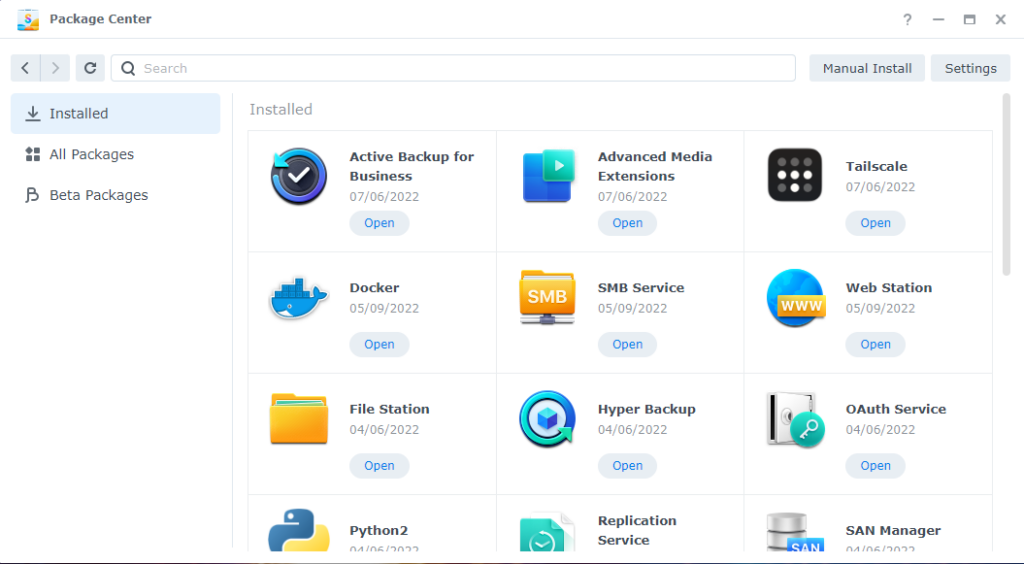
Unlike Synology, most of the TrueNAS applications are community-based. However, there are tons of tools that will help you run different applications on your NAS, like Nextcloud, Plex, Syncthing, and many more.
There are differences between the applications you can use on TrueNAS Core and TrueNAS Scale, so make sure that you check the list of software before selecting which OS you’d like to use.
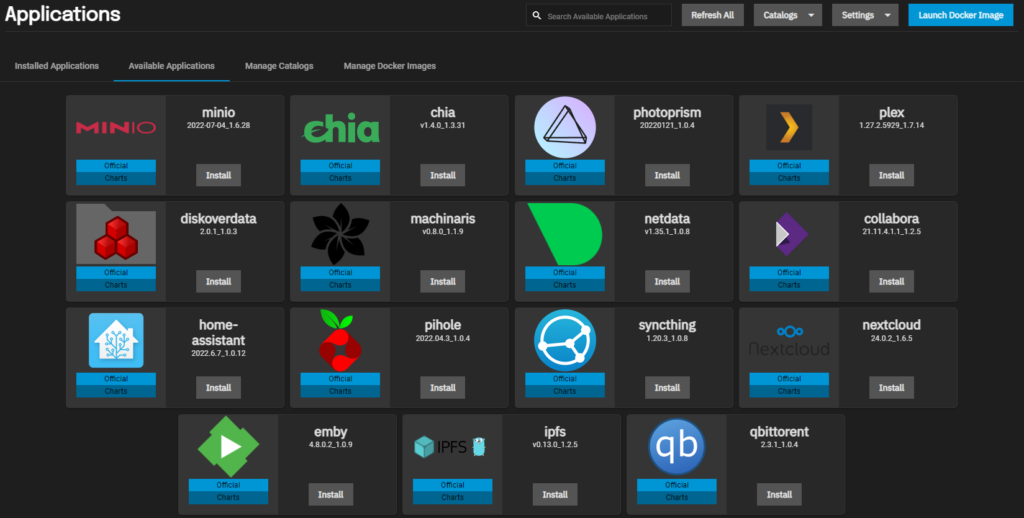
Conclusion and Final Thoughts on Synology/TrueNAS
This article looked at a side-by-side comparison of Synology vs. TrueNAS. Synology DSM and TrueNAS are extremely different. One is aimed at beginners and is powerful for advanced users who like to tinker, and the other is fairly difficult to initially understand, but extremely powerful once you do get an understanding of how it works.
I’m a huge fan of Synology DSM, but I also use TrueNAS Scale, though I use them for different things. At this point, I’ve learned to love the Synology first-party applications and for that reason, I will always own a Synology NAS.
However, it’s really great to be able to load up TrueNAS on legacy hardware (or new, if you plan on taking that route) and run it to learn more about it, or simply take the DIY approach and have a cheaper device that’s more powerful than any Synology you can buy. Just remember that things like hardware compatibility are up to you, where all Synology devices are fully supported with DSM.
I’m hopeful that this article on Synology vs. TrueNAS helped you, but if you have any questions, please leave them in the comments!



